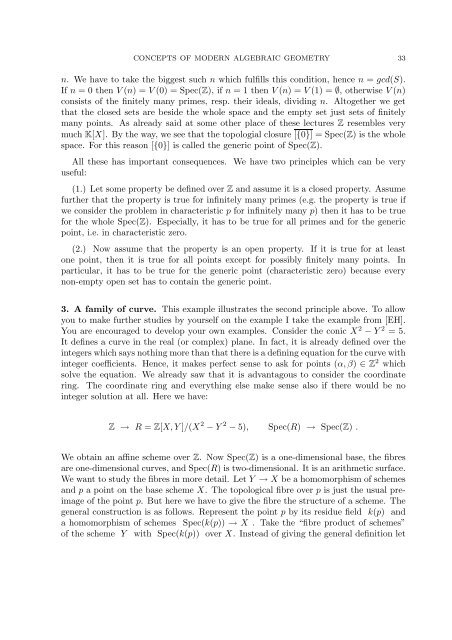Mannheimer Manuskripte 177 gk-mp-9403/3 SOME CONCEPTS OF ...
Mannheimer Manuskripte 177 gk-mp-9403/3 SOME CONCEPTS OF ...
Mannheimer Manuskripte 177 gk-mp-9403/3 SOME CONCEPTS OF ...
- No tags were found...
You also want an ePaper? Increase the reach of your titles
YUMPU automatically turns print PDFs into web optimized ePapers that Google loves.
<strong>CONCEPTS</strong> <strong>OF</strong> MODERN ALGEBRAIC GEOMETRY 33n. We have to take the biggest such n which fulfills this condition, hence n = gcd(S).If n = 0 then V (n) = V (0) = Spec(Z), if n = 1 then V (n) = V (1) = ∅, otherwise V (n)consists of the finitely many primes, resp. their ideals, dividing n. Altogether we getthat the closed sets are beside the whole space and the e<strong>mp</strong>ty set just sets of finitelymany points. As already said at some other place of these lectures Z resembles verymuch K[X]. By the way, we see that the topologial closure [{0}] = Spec(Z) is the wholespace. For this reason [{0}] is called the generic point of Spec(Z).All these has i<strong>mp</strong>ortant consequences. We have two principles which can be veryuseful:(1.) Let some property be defined over Z and assume it is a closed property. Assumefurther that the property is true for infinitely many primes (e.g. the property is true ifwe consider the problem in characteristic p for infinitely many p) then it has to be truefor the whole Spec(Z). Especially, it has to be true for all primes and for the genericpoint, i.e. in characteristic zero.(2.) Now assume that the property is an open property. If it is true for at leastone point, then it is true for all points except for possibly finitely many points. Inparticular, it has to be true for the generic point (characteristic zero) because everynon-e<strong>mp</strong>ty open set has to contain the generic point.3. A family of curve. This exa<strong>mp</strong>le illustrates the second principle above. To allowyou to make further studies by yourself on the exa<strong>mp</strong>le I take the exa<strong>mp</strong>le from [EH].You are encouraged to develop your own exa<strong>mp</strong>les. Consider the conic X 2 − Y 2 = 5.It defines a curve in the real (or co<strong>mp</strong>lex) plane. In fact, it is already defined over theintegers which says nothing more than that there is a defining equation for the curve withinteger coefficients. Hence, it makes perfect sense to ask for points (α,β) ∈ Z 2 whichsolve the equation. We already saw that it is advantagous to consider the coordinatering. The coordinate ring and everything else make sense also if there would be nointeger solution at all. Here we have:Z → R = Z[X,Y ]/(X 2 − Y 2 − 5), Spec(R) → Spec(Z) .We obtain an affine scheme over Z. Now Spec(Z) is a one-dimensional base, the fibresare one-dimensional curves, and Spec(R) is two-dimensional. It is an arithmetic surface.We want to study the fibres in more detail. Let Y → X be a homomorphism of schemesand p a point on the base scheme X. The topological fibre over p is just the usual preimageof the point p. But here we have to give the fibre the structure of a scheme. Thegeneral construction is as follows. Represent the point p by its residue field k(p) anda homomorphism of schemes Spec(k(p)) → X . Take the “fibre product of schemes”of the scheme Y with Spec(k(p)) over X. Instead of giving the general definition let
















